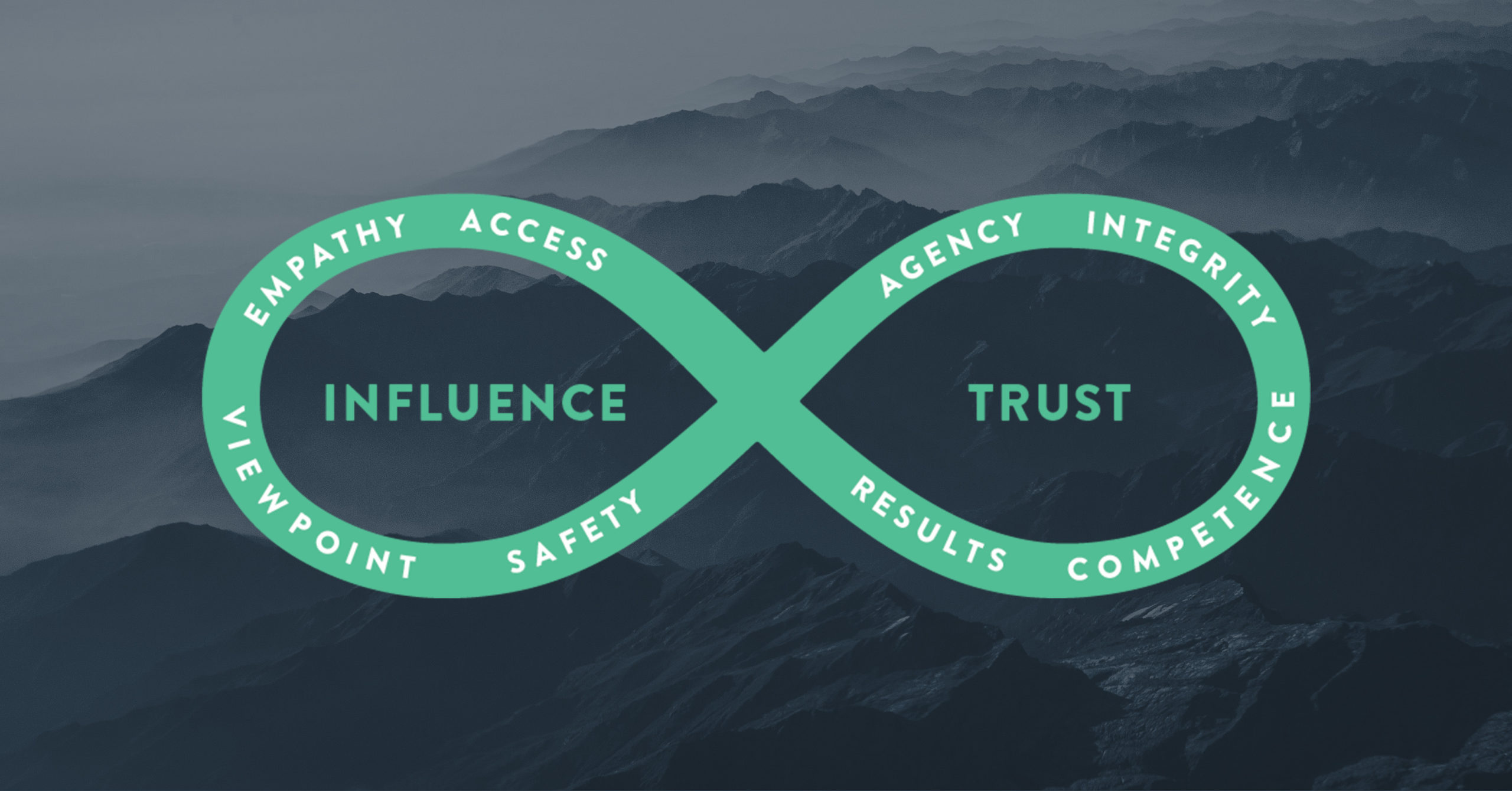The Virtuous Cycle of Trust and Influence
In today’s environment, organizations are striving for business Agility, or else they risk being put out of business. This makes it imperative that Business and IT work together in a solid partnership based on trust. It is not a tenable position to say ‘just trust us’ when the conditions necessary to build trustworthy systems and teams are non-existent.
In today’s blog, a continuation of the first in this two-part series, we’ll talk about building trust and influence, and initiating the trust-influence loop. As we mentioned in the previous blog, our strong point of view is that the Business should go first to build trust and trustworthiness, thereby blazing a path forward in which the Agile teams can proceed. But before we get to that process, let’s talk about common failure modes that get in the way.
Barriers to Trust
Many people say, “Just trust the team.” Trusting the team is important, but not if the team is in its early stages or the team has not been well-formed to begin with. Trusting the team is scary for the business because, historically, IT has not been trustworthy and doesn’t have a good track record for:
- Making and meeting commitments
- Delivering on a regular, predictable cadence
- Putting quality products into the market that the organization could sell
- Driving revenue or other business outcomes related to value
On the other hand, trusting the business is scary for IT because, historically, the business has not been trustworthy—they don’t have a good track record around:
- Communicating clear, concise, and current business problems to solve
- Dedicating Business subject matter expertise to support the delivery effort
- Providing a product roadmap for the next 12-18 months
- Setting arbitrary deadlines for delivery timeframes (sometimes they are the basis for getting contracts signed)
- Adjusting scope to meet a delivery deadline the Business had already set
- Adjusting scope based on delivery’s ability to deliver (we want it all, but can only pay for 35% or have the capacity to deliver 45%)
- Business being aligned for the many requests they have for delivery – competing or conflicting requests occur constantly
If You Want to Be Trusted…
An effective enterprise Transformation strategy is grounded in a trustworthy ecosystem around the people for them to produce products in a predictable way. Trust and trustworthiness are two sides of the same coin that foster responsibility in teams and leadership without finger-pointing or the blame game.
Trust is really only necessary when there is meaningful risk or uncertainty. If there is no risk, there is no need to trust. Transformation (aka change) is always risky and uncertain. But in an Agile Transformation, how do you become trustworthy?
Whether you are an Agile team or a Business Leader responsible for an Agile Transformation, if you want to be trusted, you must be trustworthy.
On one level, you really don’t have any control as to whether or not someone trusts you. But you do have control over whether you are worthy of that trust. And earning a level of trust can lead to earning more trust. Trustworthiness begets more and more trust.
We have found that becoming trustworthy causes another thing to occur – influence. Trust and influence are critical components in an enterprise transformation strategy. Without trust, you are not going to get permission to influence. Broadening trust and influence is the path to greater access and adoption across the organization based on business results.
 One way of describing this virtuous cycle is the Trust and Influence Loop. On the left side of the loop, we have Influence, and on the right, Trust. There are four nodes on each portion of the loop. We will start with trust then move to influence.
One way of describing this virtuous cycle is the Trust and Influence Loop. On the left side of the loop, we have Influence, and on the right, Trust. There are four nodes on each portion of the loop. We will start with trust then move to influence.
Trust
To begin with, there has to be agency, or permission, to do anything within an organization’s transformation. This normally comes through some kind of agreement with scope and constraints giving permission to coach the transformation.
Once there is agency, the work needs to be done with integrity. We need to say what we are going to do and do what we said. Sometimes we call this “calling your shot.” Like in billiards, the ball going in the pocket doesn’t count unless you say which pocket it will drop into ahead of time.
LeadingAgile calls its shot using an Outcomes-Based Plan. Every week we work with client leaders of the Transformation (we call them the Transformation Leadership Team or TLT) to state where the Transformation currently is, what needs to change in the upcoming week, and how we will execute that change. We also communicate how the Transformation is going monthly to the senior leaders of the organizational Transformation (we call them the Executive Steering Committee or ESC). The Outcomes-Based Plan is regularly inspected and adapted.
While executing the Transformation, we need to show competence, and we must be good at it. We need to have coaches, consultants, and Transformation leaders who are experts in the many aspects of Agile Transformation; from framing the Transformation, to establishing Transformation leadership within the client, to assessing capabilities, to coaching, to making the change stick.
Lastly, we have to deliver the results we promised. And when we deploy a Transformation team to a slice of the client organization, do what we said we were going to do, do it with competence, and deliver the results, then we complete a loop through the trust-building cycle. That is key to building trust and becoming trustworthy and becoming trusted. Companies will pay for that all day long.
Believe it or not, leaders don’t want to be command and control managers. They want to delegate. They just want to be safe. They want to be sure the teams they have stewardship over-deliver the things they said they were going to produce.
Influence
Once we have delivered the necessary results to complete the trust loop, we can begin to enter the influence loop. The first node of the influence loop is Access. By virtue of being allowed to show up, and by showing up you have been given access. It could be anything from access to an Agile team to the executives leading the Transformation.
Now, what do you do with this access?
On the one hand, we can show up and tell them all the things they are doing wrong, and how we are going to fix it. That will produce limited results at best. The problem is if we are not aligned with that client’s worldview, we don’t understand their problem. And if we don’t understand their problem, we won’t create safety for them, and they won’t give us permission to do anything.
A big part of influencing leaders is, once we have access, demonstrating we deeply understand their view of the problem – not the problem we think they have, but the problem they think they have. We need to do as Stephen Covey said and, “Seek first to understand, then to be understood.” It’s up to us to bridge that gap.
Once we understand the client’s problem, as they see it, we have to have a strong point of view on how to solve that problem in a way that resonates with their understanding of the problem. For example, we sit down with a client and we think their problem is around too much Work in Process (WIP). Think of this as juggling too many balls at one time. We explain to them how and why keeping WIP low reduces multi-tasking and is the best way for them to go faster.
When we understand the client’s problem the way they see it and have a solution that resonates with them, then we have created safety for them which causes them to give us permission to go do something. Once we get the agency to go do that thing, we do it with integrity and competence and deliver results. That person will call you back in and say, “That was awesome, let’s keep doing that.”
On the other hand, if the problem we are trying to resolve doesn’t align with the problem the client thinks they have, we are going to lose access and we are not going to be listened to.
As a team that wants to be trusted, we put ourselves in the best possible situation if we become trustworthy first. Then we can keep looping through the trust loop. The moment we don’t get the results we promised, we will stop getting agency and stop getting access.
If we are going through a Transformation, and let’s say we are a Scrum Master, and we are trying to influence our leadership, to help create the conditions in which that group can be trustworthy. We might get access and we would have to be clear that the solution we would put in place is actually going to solve a problem that the executive cares about. We have to communicate to them in a way that demonstrates what we’re going to do will solve that problem. We have to create a tremendous amount of safety. Then we better make sure once we have permission that we’re actually able to deliver the results we promised.
Whether we’re thinking about the idea that trustworthiness begets trust or walking the trust loop lets us be more influential, not doing what we said we’re going to do is going to erode our trustworthiness and our influence. This will occur even if we’re well-intentioned and working hard.
So, as we think about the topic of trust and trustworthiness, think of it as physics, as a non-negotiable. We have to be trustworthy in order to be trusted.


